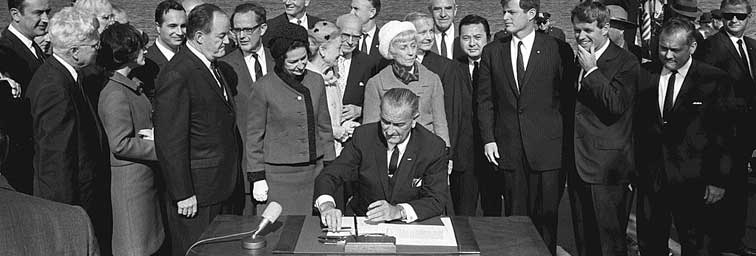
1965 and All That: Federal Laws That Increase Population and Illegal Immigration
- Edwin S. Rubenstein
- June 28, 2018
- Forum Papers
- Forum Paper
- 0 Comments
![]() Your gift helps publish and distribute materials like this.
Your gift helps publish and distribute materials like this.
Click here for a downloadable, printable PDF version
1965 and All That: Federal Laws That Increase Population and Illegal Immigration
An NPG Forum Paper
by Edwin S. Rubenstein
The U.S. has never had a formal population policy – has never tried to directly limit population growth or fertility rates. Any such policy would likely start with constraints on groups with the highest fertility rates: the poor, the poorly educated, minorities, and immigrants. The politics of such a move would be daunting. Charges of racism, elitism, and government meddling in a decision best left to husband and wife, are unavoidable. Government interference in these matters is simply un-American.
Yet the same groups opposed to direct population controls are staunch advocates of Federal policies that do the opposite: increase fertility and population growth. This paper examines three of them: the 1965 Immigration Act, the Earned Income Tax Credit, and the Emergency Medical Treatment and Active Labor Act. (EMTALA). These programs were not designed with population growth in mind. They achieve that result indirectly, by promoting family reunification, paying cash benefits that rise with family size, and offering free medical care to illegal aliens. Each has made a profound impact on the size and demographics of their target populations.
THE 1965 IMMIGRATION ACT
“The bill that we sign today is not a revolutionary bill. It does not affect the lives of millions. It will not reshape the structure of our daily lives, or really add importantly to either our wealth or our power…The days of unlimited immigration are past.” – President Lyndon B. Johnson at the signing ceremony, October 3, 1965.
“[O]ur cities will not be flooded with a million immigrants annually. Under the proposed bill, the present level of immigration remains substantially the same…Secondly, the ethnic mix of the country will not be upset….”1 Senator Edward Kennedy (D-MA), the bill’s floor manager in 1965.
“Total quota immigration is now 156,782; under the proposed bill it would rise to 164,482.”2 – Senator Robert F. Kennedy (D-NY).
The 1965 Immigration Act literally changed the face of America. It gave rise to an era of mass immigration – both legal and illegal – and unleashed demographic forces that radically changed the size and composition of U.S. population. When the law was being debated, however, these mega trends were beyond the imagination of lawmakers. It was the height of the civil rights movement. The historical significance of the new law lay primarily in that it would replace the national origins quotas that had been in place since the 1920s.
The 1921 National Origins Act capped annual immigration for each country at 2% of a country’s immigrant population in the 1890 Census. The formula was designed to favor Western and Northern European immigrants at the expense of those from Southern and Eastern Europe, where most post-1890 immigrants came from. For this reason, the 1921 legislation is widely called “racist.”
From the perspective of 2018, the most persuasive evidence that this law was color blind is the absence of any numerical limit on immigrants from Mexico or any other Western Hemisphere country. It created a de facto open border regime, under which a Mexican could purchase a U.S. visa (for 5 cents) and enter legally.3 American employers hired plenty of them. But the need for such labor was attenuated, in part because the government “safety net” was, by today’s standards, rudimentary – available only for natives who were genuinely unable to work. Under these circumstances, there are few jobs that Americans “do not want to do.”[…]
Continue reading the full Forum paper by clicking here.
Ed Rubenstein, president of ESR Research, is an experienced business researcher, financial analyst, and economics journalist. He has written extensively on federal tax policy, government waste, the Reagan legacy, and – most recently – on immigration. He is the author of two books: The Right Data (1994) and From the Empire State to the Vampire State: New York in a Downward Transition (with Herbert London). His essays on public policy have appeared in The Wall Street Journal, The New York Times, Harvard Business Review, Investor’s Business Daily, Newsday, and National Review. His TV appearances include Firing Line, Bill Moyers, McNeil-Lehr, CNBC, and Debates-Debates. Mr. Rubenstein has a B.A. from Johns Hopkins and a graduate degree in economics from Columbia University.

